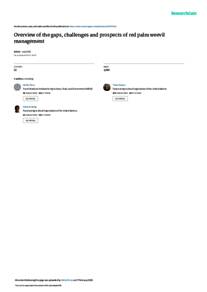وثيقة
Overview of the gaps, challenges and prospects of red palm weevil management.
المعرف
DOI: 10.22268/AJPP-037.2.170177
المصدر
Arab Journal of Plant Protection. v. 37, 2, p. 170-177
المساهمون
الدولة
Lebanon.
الناشر
Arab Society for Plant Protection.
اللغة
الأنجليزية
الملخص الإنجليزي
The Red Palm Weevil (RPW) Rhynchophorus ferrugineus Olivier has emerged as a key pest of palms in diverse agro-ecosystems worldwide. RPW has its home in South and South-East Asia where it has been a major pest of coconut. Ever since it was reported on date palm in the Middle East during the mid-1980s, it has spread rapidly mainly through infested planting material. Recent reports of RPW invasion suggest that the pest is gaining foot hold in the Caucasian region where it is detected from Sochi in Russia and Abkhazia in the republic of Georgia and also from East Africa in Djibouti. The current RPW IPM programmes, based on pheromone/bait trapping among other techniques have been implemented with limited success. Gaps and challenges in almost all the components of the strategy, particularly with regard to early detection of the pest, developing and implementing phytosanitary measures, lack of farmer participation in the programmes and scarcity of data on socio-economic issues among several other factors have made RPW control and eradication extremely difficult. On the positive side, the pest has been eradicated in the Canary Islands and is approaching eradication in Mauritania. Eradication has also been obtained in various oasis in Oman but new introductions of infested palms have ruined these successes. The Food and Agriculture Organization of the UN during the Scientific and High Level Meeting on the Management of RPW in March, 2017 called for the urgent need to combat RPW by collaborative efforts and commitments at the country, regional and global levels to stop the spread of this devastating pest and formulated a framework strategy for eradication of RPW which aims to support efforts/programs of countries to stop its spread, to achieve a strong decline and if possible its eradication. This has led to the ‘FAO Programme on RPW Eradication in the NENA Region’ to intensify governance, monitoring, scientific research, capacity building and coordination. The program fosters the ongoing research on the applicable approaches of biological control and innovative detection and control methods. Furthermore, the ‘FAO Global RPW management platform’ aims mainly at monitoring the pest using mobile apps and GIS based techniques. This presentation highlights the gaps and challenges in the current RPW-IPM strategy with prospects for improving each component of the RPW-IPM program, based on a much better knowledge on the socioeconomic situation and the participation of the farmers and other stakeholders.
ISSN
0255-982X
قالب العنصر
مقالات الدوريات

